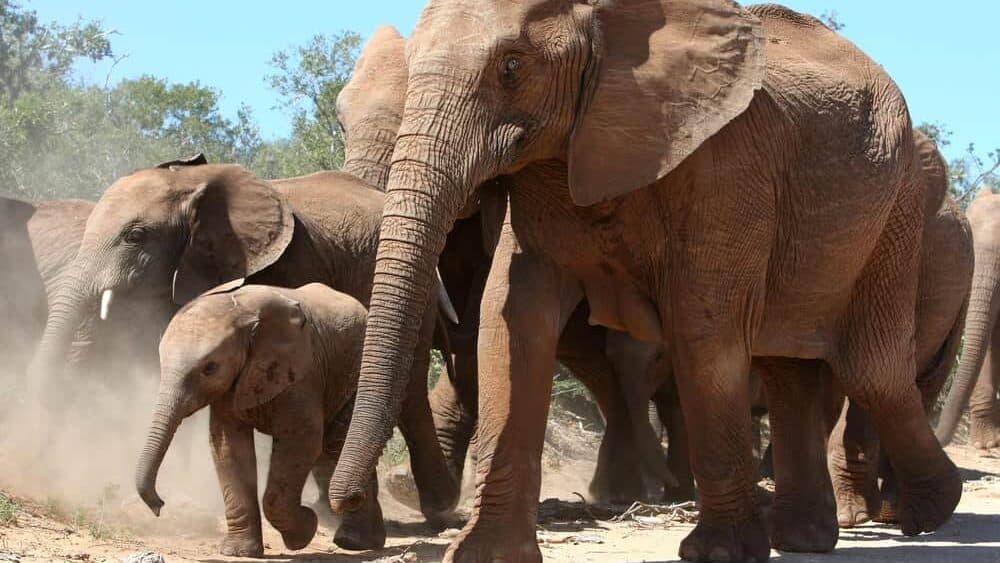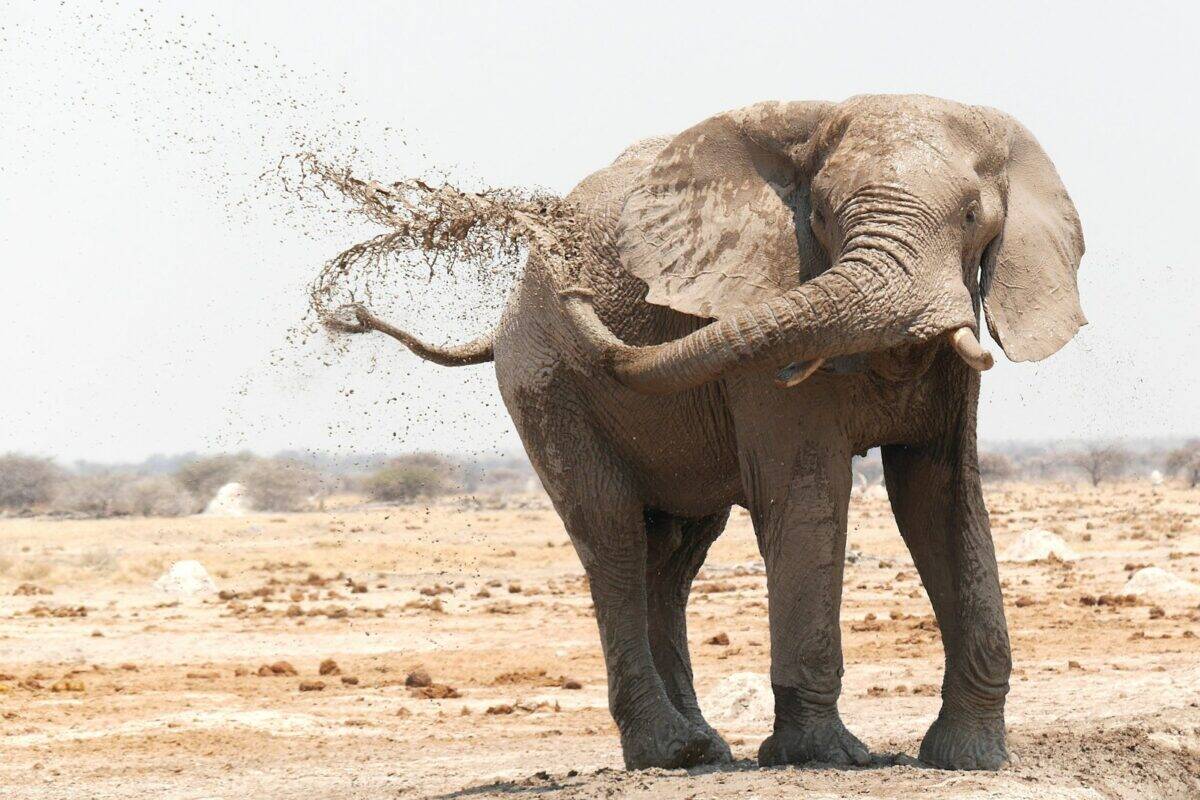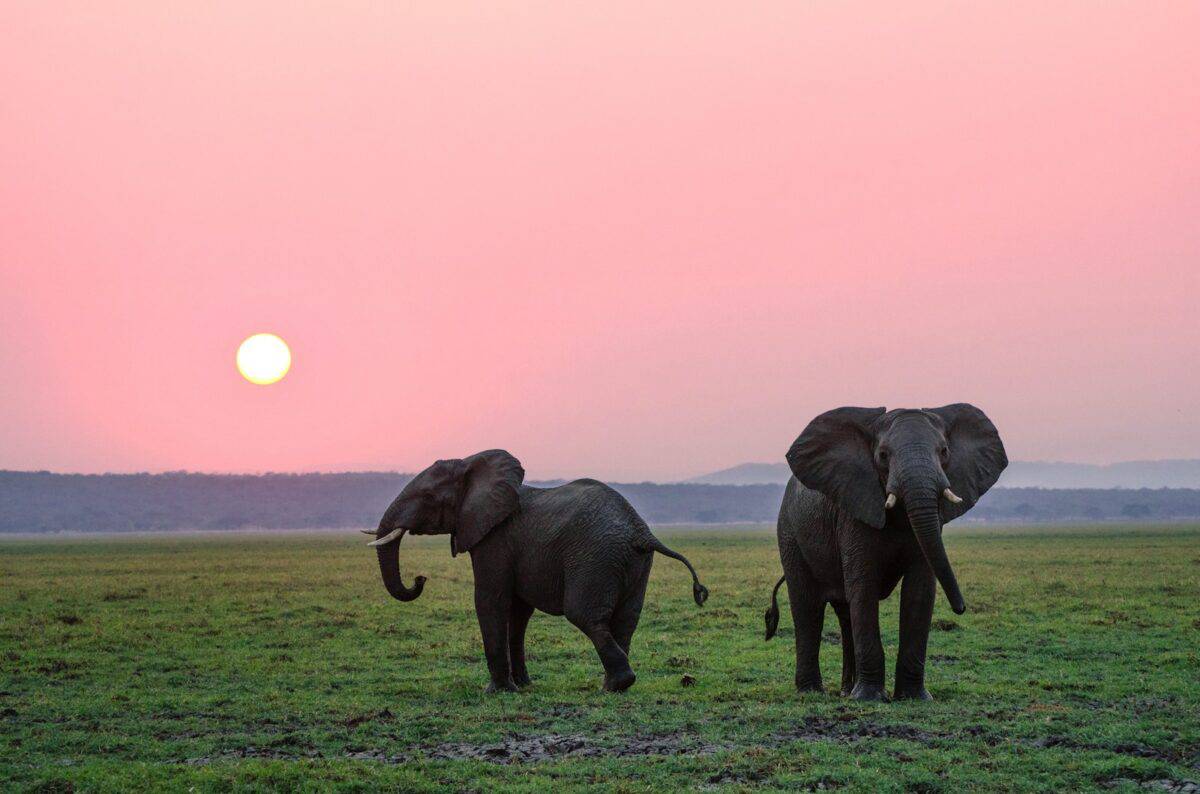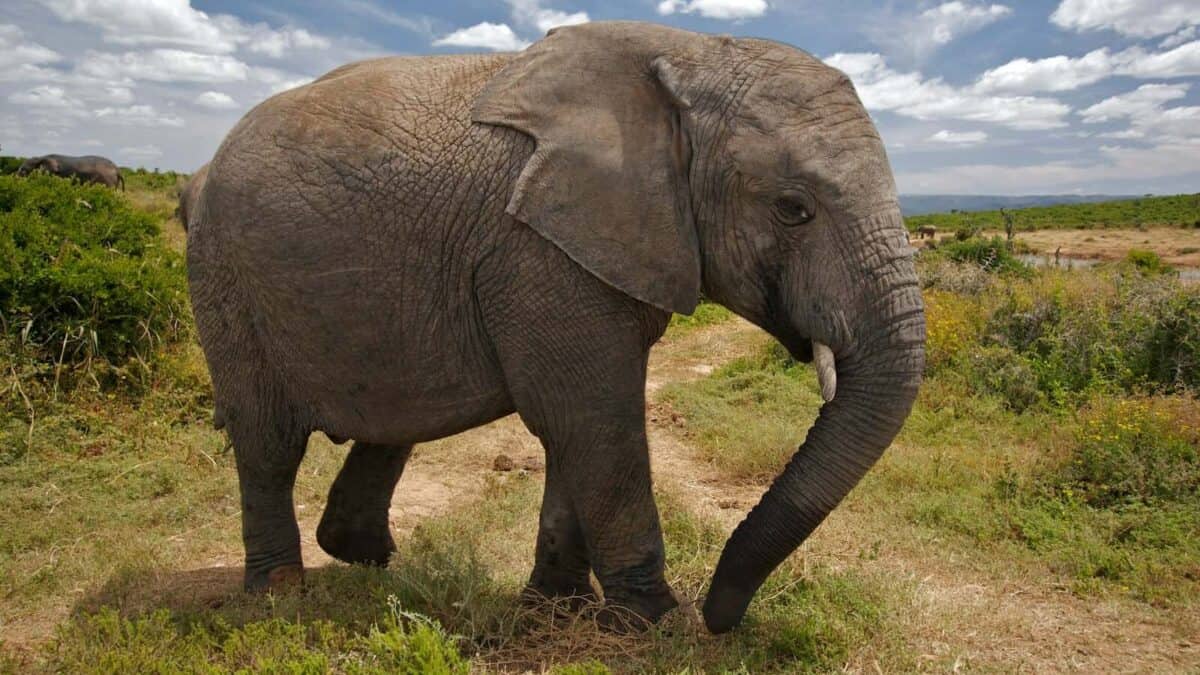Elephants, the largest land mammals on Earth, do much more than simply exist within their environments—they actively shape and transform them. Renowned ecologists and wildlife experts have designated these magnificent creatures as “ecosystem engineers” due to their profound impact on the landscapes they inhabit. From the African savannas to the Asian forests, elephants modify their surroundings in ways that benefit countless other species, creating a ripple effect throughout entire ecosystems. Their size, behavior, and ecological requirements make them pivotal species whose presence or absence dramatically alters the environment around them. In this article, we’ll explore the ten significant ways elephants earn their title as nature’s engineers, revealing how these gentle giants are indispensable architects of healthy, biodiverse ecosystems.
Creating Water Access Points Through Digging

During dry seasons when water becomes scarce, elephants transform into natural well-diggers. Using their powerful trunks, tusks, and feet, they can excavate holes in dry riverbeds up to three feet deep, accessing groundwater that would otherwise remain untapped. These elephant-created water sources become lifelines not just for the elephants themselves but for countless other species. Research in Hwange National Park, Zimbabwe, has documented over 30 different mammal species utilizing elephant-dug waterholes during drought periods. The significance of this behavior extends beyond immediate survival; these water access points can persist for years, becoming permanent features of the landscape that support biodiversity through successive dry seasons. By creating these oases in otherwise parched environments, elephants demonstrate one of their most crucial roles as ecosystem engineers.
Seed Dispersal on an Impressive Scale

Elephants are unparalleled seed dispersers, transporting plant genetic material across vast distances in a way few other animals can match. A single elephant can consume over 500 pounds of vegetation daily, including fruits, seeds, and plant matter from numerous species. These seeds travel through the elephant’s digestive system, typically for 12-18 hours, before being deposited in nutrient-rich dung up to 50 miles from where they were consumed. Studies in Thailand’s Khao Yai National Park have identified more than 130 plant species that depend on elephants for seed dispersal. The seeds benefit not only from transportation but also from the digestive process itself, which often breaks down hard outer casings and improves germination rates. One fascinating example is the African marula tree, whose seeds show germination rates up to 400% higher after passing through an elephant’s digestive tract. This long-distance seed dispersal helps maintain genetic diversity within plant populations and allows colonization of new areas, making elephants vital contributors to forest regeneration and ecosystem resilience.
Landscape Transformation Through Feeding Habits

Elephants dramatically reshape landscapes through their feeding behaviors, converting dense woodland into more open, mixed habitat mosaics. An adult elephant can push over trees up to 40 feet tall to access higher leaves or strip bark, creating light gaps in the forest canopy. This opening of dense vegetation allows sunlight to reach the forest floor, promoting the growth of sun-loving plant species that wouldn’t otherwise thrive. In studies conducted in Kruger National Park, areas with elephant activity showed 30% higher plant diversity than similar areas where elephants had been excluded. The transition from woodland to more open savanna creates habitat heterogeneity—a varied landscape that supports a wider range of wildlife species than either closed forest or open grassland alone. By maintaining this balance between wooded areas and open spaces, elephants prevent any single vegetation type from dominating, ensuring habitat availability for grazers, browsers, and the predators that depend on them. This constant reshaping of the landscape represents one of the most visible and significant ways elephants function as ecosystem engineers.
Creating Pathways That Serve as Wildlife Corridors

As elephants move through their environment, they create well-defined pathways that can persist for decades, some extending for hundreds of miles across landscapes. These elephant-made trails serve as natural infrastructure for countless other species. In the dense forests of Central Africa, researchers have documented over 30 different mammal species regularly using elephant pathways, from small rodents to large predators like lions. These trails provide efficient travel routes through otherwise difficult terrain, connecting different habitat types and resources. They’re particularly valuable during seasonal migrations when they guide animals to water sources or feeding grounds. In addition, elephant pathways often follow optimal routes through challenging landscapes—crossing rivers at the shallowest points or navigating the gentlest slopes in mountainous regions. During forest fires, these same pathways can function as escape routes for wildlife. By creating this network of animal highways, elephants engineer connectivity across landscapes, facilitating movement that’s essential for genetic exchange between wildlife populations and allowing species to access resources that would otherwise be isolated.
Dung as a Microhabitat and Nutrient Source

Elephant dung represents a remarkable ecosystem in miniature. Each pile—and an elephant can produce up to 300 pounds daily—becomes a specialized microhabitat and nutrient hotspot. More than 100 insect species have been identified as specifically associated with elephant dung, from dung beetles that use the material for reproduction to flies, termites, and other decomposers. This concentration of insects attracts insectivorous birds, mammals, and reptiles, creating localized biodiversity hotspots. Beyond its value as habitat, elephant dung serves as a significant nutrient transfer mechanism. Containing partially digested plant matter rich in nitrogen, phosphorus, and potassium, it effectively redistributes these essential nutrients across landscapes. Studies in Uganda’s Queen Elizabeth National Park have shown that areas with high elephant dung deposition have soil nutrient concentrations up to 50% higher than surrounding areas. Seeds within the dung benefit from this nutrient-rich germination environment, while the surrounding vegetation experiences enhanced growth. This nutrient redistribution is particularly important in nutrient-poor ecosystems where elephants transport fertility from resource-rich areas to more depleted zones, effectively engineering the soil fertility patterns across their range.
Maintaining Grassland Ecosystems

In savanna ecosystems, elephants play a crucial role in preventing woodland encroachment and maintaining open grasslands. Without elephant activity, many African savannas would gradually transition to closed-canopy woodland as trees outcompete grasses. By selectively feeding on woody vegetation, pushing over trees, and stripping bark—behaviors that often kill or suppress tree growth—elephants help maintain the characteristic savanna balance of scattered trees amid expansive grasslands. This habitat maintenance has far-reaching consequences for biodiversity. The grassland ecosystems that elephants help preserve support the highest concentration of large mammal species on Earth, including the great migratory herds of wildebeest, zebra, and gazelle in East Africa. Research in Tanzania’s Serengeti ecosystem demonstrates that areas with healthy elephant populations maintain approximately 40% more grazing mammal biomass than areas where elephants have been eliminated. The ecological ripple effects extend to predators like lions and cheetahs that depend on the visibility and hunting opportunities provided by open grasslands. By engineering these savanna landscapes, elephants indirectly support entire food webs and maintain one of the planet’s most biodiverse ecosystem types.
Creating Gaps in Forest Canopies

In forested environments, elephants create crucial light gaps in the canopy through their feeding and movement patterns. When elephants push over trees or break branches to access food, they open the dense forest canopy, allowing sunlight to reach the forest floor. These light gaps trigger a succession process that dramatically enhances biodiversity. Studies in Congo Basin forests have documented up to 200% higher plant species diversity in elephant-created clearings compared to undisturbed forest. The increased light levels enable the growth of pioneer plant species that wouldn’t otherwise survive in the deep shade, creating patches of early-successional habitat within mature forests. These diverse vegetation patches attract different insect communities, which in turn support a greater variety of birds and other wildlife. The mosaic of different-aged forest patches that results from elephant disturbance creates habitat complexity that accommodates species with varying ecological requirements. Even seemingly destructive behaviors, like bark stripping that may kill individual trees, contribute to the creation of standing dead trees that provide essential habitat for cavity-nesting birds, bats, and countless invertebrates. Through these activities, elephants engineer forests with greater structural complexity and biodiversity than would exist without their influence.
Salt Lick Creation and Maintenance

Elephants are geological engineers, creating and maintaining natural mineral deposits known as salt licks that serve countless species. Using their tusks and trunks, elephants excavate specific soil and rock layers to access essential minerals like calcium, magnesium, and sodium that may be lacking in their plant-based diet. These excavations can be substantial—some elephant-maintained salt licks in Malaysia’s rainforests extend several meters into hillsides and have been used continuously for generations. Research in Kenya’s Amboseli ecosystem has documented over 40 different mammal species regularly visiting elephant-created salt licks. These sites become mineral resource centers for the entire ecosystem, allowing herbivores to supplement their diets with otherwise scarce nutrients essential for bone development, milk production, and other physiological functions. Predators often patrol these areas, knowing they attract potential prey. By creating and maintaining these mineral access points, elephants engineer a resource that supports the nutritional needs of their entire ecological community, demonstrating how their behaviors provide benefits that extend far beyond their own species.
Promoting Tree Regeneration Through Disturbance

While elephants are often portrayed as destructive to trees, their activities actually promote forest regeneration through carefully balanced disturbance. By creating soil disturbance, opening canopy gaps, and reducing competition from established vegetation, elephants create ideal conditions for tree seedling establishment. Research in Uganda’s Kibale National Park has shown that moderate elephant disturbance can increase tree seedling density by up to 125% compared to undisturbed forest areas. This is particularly important for light-demanding pioneer tree species that depend on canopy gaps to regenerate. The relationship is often cyclical—elephants may reduce tree density in the short term but create conditions that favor robust tree regeneration in the long term. Additionally, elephants selectively feed on different tree species, influencing forest composition in ways that often increase diversity. They typically avoid certain unpalatable species while targeting others, creating competitive advantages and disadvantages that shape forest succession. In many African and Asian ecosystems, certain tree species have co-evolved with elephants, developing features like rapid growth, sprouting abilities, or protective mechanisms that allow them to thrive despite elephant browsing. Through these complex interactions, elephants engineer dynamic forests that continuously regenerate rather than static plant communities.
Influencing Fire Regimes

Elephants significantly impact wildfire patterns in their ecosystems, engineering fire-resilient landscapes through their feeding and movement behaviors. By reducing grass biomass in heavily utilized areas, elephants create natural firebreaks that can slow or stop the spread of wildfires. Studies in South Africa’s Kruger National Park have shown that areas with high elephant activity experience approximately 40% fewer severe wildfires than similar habitats without elephants. Conversely, by opening woodland canopies, elephants may increase grass growth in certain areas, potentially increasing fire frequency but reducing intensity due to the patchy nature of the fuel load. This creation of heterogeneous fire patterns is ecologically valuable, as it prevents landscape-scale devastating fires while maintaining the beneficial effects of periodic, low-intensity burns. Many African ecosystems are fire-adapted, requiring occasional burns for seed germination and vegetation renewal. By engineering a mosaic of different vegetation densities and types, elephants help maintain appropriate fire regimes that support biodiversity. Their pathways also serve as firebreaks during wildfires, creating escape routes for wildlife. Through these direct and indirect influences on fire patterns, elephants help engineer ecosystems with natural resilience to this powerful ecological force.
Protecting Other Species Through Umbrella Effects

As ecosystem engineers with enormous spatial requirements, elephants create conservation umbrella effects that protect countless other species. An elephant family group may range across territories spanning hundreds of square miles, and protecting this habitat for elephants automatically safeguards habitat for thousands of other species that share these landscapes. Conservation initiatives targeting elephants in both Africa and Asia have led to the protection of over 20 million hectares of habitat that benefits entire ecological communities. The ecological engineering performed by elephants creates and maintains habitat features needed by species with specialized requirements. For instance, the cavities elephants create in baobab trees provide essential roosting sites for species like the African scops owl. The water holes they dig during droughts sustain entire communities of aquatic invertebrates, amphibians, and water-dependent vertebrates. Research in Tanzania’s Tarangire ecosystem demonstrated that areas under elephant conservation management supported 42% more vertebrate species than similar areas without elephant protection. By serving as charismatic flagships for conservation while simultaneously engineering habitats that support ecological complexity, elephants create a powerful double benefit—protecting landscapes from human exploitation while actively enhancing their ecological value through their engineering behaviors.
Conclusion: The Irreplaceable Ecosystem Engineers

Elephants stand as nature’s quintessential ecosystem engineers, transforming and maintaining the environments they inhabit in ways no other species can replicate. Their unique combination of massive size, intelligence, social complexity, and wide-ranging movements allows them to influence ecosystems at scales from microscopic soil interactions to landscape-level vegetation patterns. The ten engineering functions we’ve explored—from creating water sources and dispersing seeds to maintaining grasslands and influencing fire regimes—demonstrate how deeply embedded elephants are in the ecological fabric of their native habitats. As elephant populations decline due to poaching, habitat loss, and human conflict, we risk not just losing a magnificent species but unraveling entire ecological systems that have co-evolved with these ecosystem engineers over millions of years. Conservation efforts that recognize and protect elephants’ engineering roles are essential for maintaining healthy, functioning ecosystems that support biodiversity and provide vital services to human communities as well. By understanding and valuing elephants as irreplaceable ecosystem engineers, we gain powerful motivation to ensure these remarkable architects of nature continue to shape our planet’s wild landscapes for generations to come.
- 12 Most Googled Creatures of the Deep Ocean - August 25, 2025
- 13 Most Aggressive Mammals in the Wild - August 24, 2025
- 10 Behaviors That Keep Eagles Healthy And 3 That Shorten Lifespan - August 24, 2025

